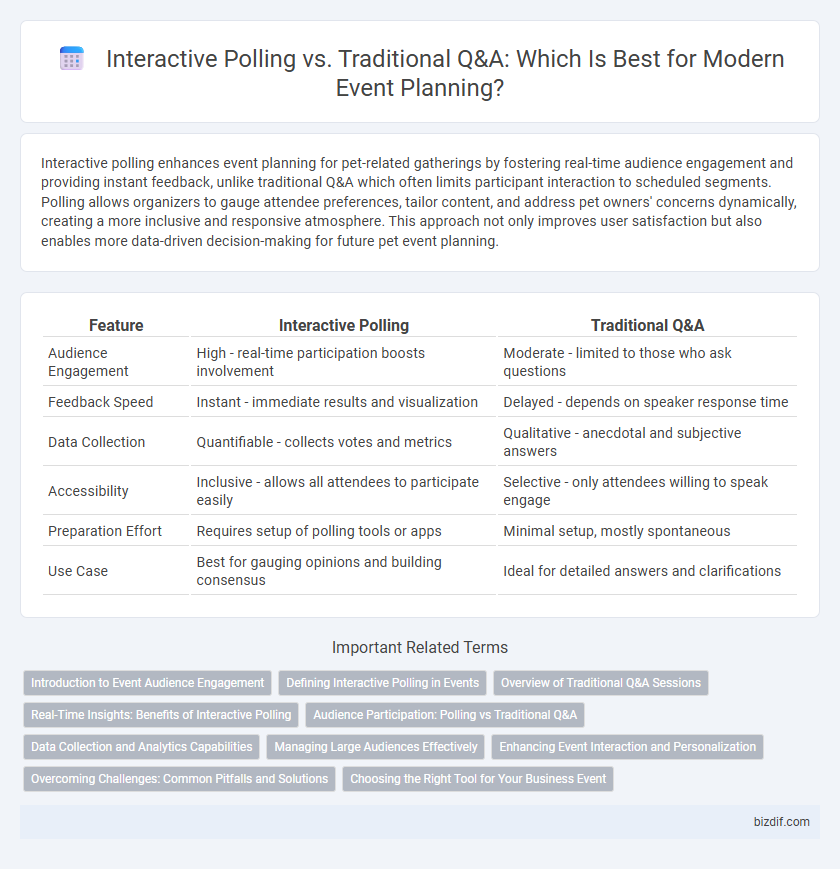Interactive polling enhances event planning for pet-related gatherings by fostering real-time audience engagement and providing instant feedback, unlike traditional Q&A which often limits participant interaction to scheduled segments. Polling allows organizers to gauge attendee preferences, tailor content, and address pet owners' concerns dynamically, creating a more inclusive and responsive atmosphere. This approach not only improves user satisfaction but also enables more data-driven decision-making for future pet event planning.
Table of Comparison
| Feature | Interactive Polling | Traditional Q&A |
|---|---|---|
| Audience Engagement | High - real-time participation boosts involvement | Moderate - limited to those who ask questions |
| Feedback Speed | Instant - immediate results and visualization | Delayed - depends on speaker response time |
| Data Collection | Quantifiable - collects votes and metrics | Qualitative - anecdotal and subjective answers |
| Accessibility | Inclusive - allows all attendees to participate easily | Selective - only attendees willing to speak engage |
| Preparation Effort | Requires setup of polling tools or apps | Minimal setup, mostly spontaneous |
| Use Case | Best for gauging opinions and building consensus | Ideal for detailed answers and clarifications |
Introduction to Event Audience Engagement
Interactive polling fosters real-time audience participation by allowing attendees to respond to questions instantly through digital platforms, enhancing engagement and providing immediate insights. Traditional Q&A sessions enable direct communication between speakers and participants but often limit interaction to verbal exchange, potentially reducing overall audience involvement. Utilizing interactive polling in event planning elevates audience engagement by combining instant feedback with dynamic participation, making sessions more inclusive and measurable.
Defining Interactive Polling in Events
Interactive polling in events leverages real-time audience engagement by allowing participants to submit responses via digital platforms, enhancing feedback accuracy and participation rates. This method facilitates instant data collection and visualization, enabling hosts to tailor content dynamically based on audience insights. Unlike traditional Q&A sessions, interactive polling fosters a more inclusive and engaging environment by encouraging active involvement from all attendees.
Overview of Traditional Q&A Sessions
Traditional Q&A sessions in event planning involve a straightforward format where attendees ask questions verbally or in writing, and speakers respond in real-time. This method fosters direct interaction but can be limited by time constraints and audience participation levels. Organizers often face challenges managing lengthy or repetitive questions, which can hinder the session's overall engagement and flow.
Real-Time Insights: Benefits of Interactive Polling
Interactive polling provides real-time insights by capturing audience feedback instantly, allowing event planners to adjust content and engagement strategies dynamically. Unlike traditional Q&A, which relies on selective participation and delayed responses, interactive polls offer comprehensive data from the entire audience, enhancing decision-making accuracy. This immediate access to participant opinions improves the overall event experience and boosts attendee satisfaction through active involvement.
Audience Participation: Polling vs Traditional Q&A
Interactive polling significantly enhances audience participation by allowing real-time feedback and engagement through instant voting, which keeps attendees actively involved. In contrast, traditional Q&A sessions often limit participation to a few individuals, reducing overall interaction and audience engagement. Polling tools also provide anonymized responses that encourage honest input, making them more effective for gauging audience opinion than conventional question-and-answer formats.
Data Collection and Analytics Capabilities
Interactive polling offers real-time data collection and instant analytics, enabling event planners to gauge audience engagement and preferences with high accuracy. Traditional Q&A sessions provide qualitative insights but lack the structured data output necessary for comprehensive analysis. Leveraging interactive polling tools enhances decision-making by transforming attendee feedback into actionable metrics.
Managing Large Audiences Effectively
Interactive polling enhances audience engagement by enabling real-time feedback and immediate data visualization, making it easier to gauge audience sentiment during large events. Traditional Q&A sessions often become time-consuming and may limit audience participation due to the need for individual speakers and slower interaction. Leveraging interactive polling tools allows event planners to manage large audiences effectively by collecting diverse input quickly and maintaining event momentum.
Enhancing Event Interaction and Personalization
Interactive polling transforms event engagement by allowing real-time audience participation, leading to higher attention and personalized feedback compared to traditional Q&A sessions. It enables organizers to tailor content dynamically based on live responses, enhancing the relevance and impact of the event. Traditional Q&A often limits interaction to a few participants, while interactive polling ensures inclusive involvement and data-driven insights.
Overcoming Challenges: Common Pitfalls and Solutions
Interactive polling enhances audience engagement by providing real-time feedback, avoiding the passive reception common in traditional Q&A sessions. Challenges such as technical difficulties and low participation can be mitigated through user-friendly polling platforms and clear instructions. Ensuring anonymity and timely display of results encourages honest input and maintains audience interest throughout the event.
Choosing the Right Tool for Your Business Event
Interactive polling enhances engagement by allowing real-time audience feedback, making it ideal for dynamic presentations and workshops. Traditional Q&A sessions offer direct dialogue, fostering deeper conversations and clarifying complex topics during conferences or seminars. Selecting the right tool depends on your event objectives, audience size, and desired level of interaction to maximize participation and information exchange.
Interactive polling vs Traditional Q&A Infographic

 bizdif.com
bizdif.com